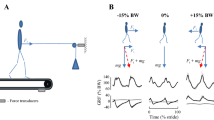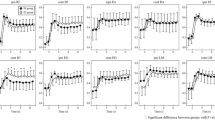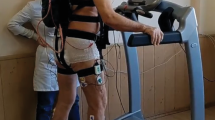Abstract
Lower-limb movements and muscle-activity patterns were assessed from seven normal and seven ambulatory subjects with incomplete spinal-cord injury (SCI) during level and uphill treadmill walking (5, 10 and 15°). Increasing the treadmill grade from 0° to 15° induced an increasingly flexed posture of the hip, knee and ankle during initial contact in all normal subjects, resulting in a larger excursion throughout stance. This adaptation process actually began in mid-swing with a graded increase in hip flexion and ankle dorsiflexion as well as a gradual decrease in knee extension. In SCI subjects, a similar trend was found at the hip joint for both swing and stance phases, whereas the knee angle showed very limited changes and the ankle angle showed large variations with grade throughout the walking cycle. A distinct coordination pattern between the hip and knee was observed in normal subjects, but not in SCI subjects during level walking. The same coordination pattern was preserved in all normal subjects and in five of seven SCI subjects during uphill walking. The duration of electromyographic (EMG) activity of thigh muscles was progressively increased during uphill walking, whereas no significant changes occurred in leg muscles. In SCI subjects, EMG durations of both thigh and leg muscles, which were already active throughout stance during level walking, were not significantly affected by uphill walking. The peak amplitude of EMG activity of the vastus lateralis, medial hamstrings, soleus, medial gastrocnemius and tibialis anterior was progressively increased during uphill walking in normal subjects. In SCI subjects, the peak amplitude of EMG activity of the medial hamstrings was adapted in a similar fashion, whereas the vastus lateralis, soleus and medial gastrocnemius showed very limited adaptation during uphill walking. We conclude that SCI subjects can adapt to uphill treadmill walking within certain limits, but they use different strategies to adapt to the changing locomotor demands.
Similar content being viewed by others
Author information
Authors and Affiliations
Additional information
Received: 10 March 1998 / Accepted: 29 December 1998
Rights and permissions
About this article
Cite this article
Leroux, A., Fung, J. & Barbeau, H. Adaptation of the walking pattern to uphill walking in normal and spinal-cord injured subjects. Exp Brain Res 126, 359–368 (1999). https://doi.org/10.1007/s002210050743
Issue Date:
DOI: https://doi.org/10.1007/s002210050743




